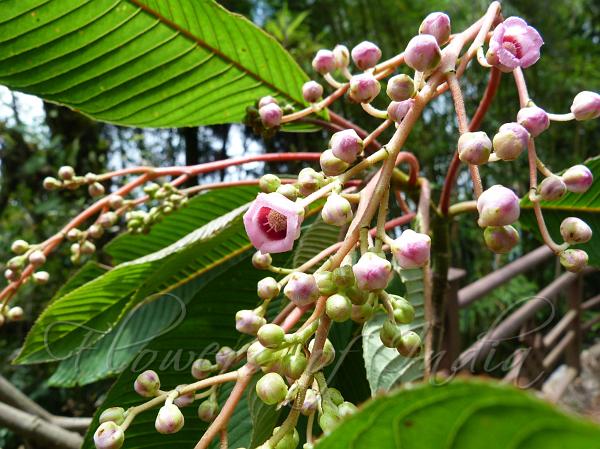|
| Gogan |
|

|

| File size | 468619 |
| Original date | 6/4/16 10:46 AM |
| Resolution | 2560 x 1920 |
| Flash | Flash did not fire, auto |
| Focal length | 4.5mm |
| Exposure time | 1/200s |
| Aperture | 4.0 |
| Focus Distance | |
| Metering Mode | Multi-segment |
| Camera make | Panasonic |
| Camera model | DMC-FZ40 |
| Sensor type | OneChipColorArea |
|
|
|
|
Photo: |
Botanical name: Saurauia napaulensis Family: Actinidiaceae (Kiwifruit family)
Gogan is a tree from the Himalayas, up 4-20 m tall.
Branchlets are brown velvety to smooth. Leaf-stalks are 2.5-5 cm.
Leaves are narrowly elliptic to oblong-obovate, 13-36 cm long, 7-15 cm
broad, thinly leathery, sparsely rusty velvety below, smooth above,
with prominent lateral veins 28-40 pairs, base blunt to rounded to
wedge-shaped, margin finely toothed, tip long-pointed to pointed.
Flowers are borne in clusters 12-33 cm long in leaf axils, carried on
stalks about half as long as the cluster. with 1 or 2 bracts at base of
each branch. Flower-stalks are 1.7-2.5 cm, with 2 nearly opposite
bracteoles below middle. Flowers are pink to purplish, 0.8-1.5 cm in
diameter. Sepals are unequal, outer 3 smaller, elliptic to broadly
elliptic, inner 2 larger, broadly elliptic to circular, 5-7 mm. Petals
are oblong, about 8 mm, fused at base, curled back at apex. Stamens are
50-90. Ovary is spherical, styles 4 or 5, fused below the middle. Fruit
are green to yellowish, spherical to depressed-spherical, ribbed or
slightly ribbed. Gogan is found in the Himalayas, from Garhwal to NE
India, N. Burma, Thailand, Indo-China and W. China, at altitudes of
750-2100 m. Flowering: May-December.
Medicinal uses:  The plant Lecanthus peduncularis is mixed with the bark of
Saurauia napaulensis in equal amount and is pounded - the
resultant juice, about 4 teaspoons a day, is given to relieve fever.
The plant Lecanthus peduncularis is mixed with the bark of
Saurauia napaulensis in equal amount and is pounded - the
resultant juice, about 4 teaspoons a day, is given to relieve fever.
 The plant Lecanthus peduncularis is mixed with the bark of
Saurauia napaulensis in equal amount and is pounded - the
resultant juice, about 4 teaspoons a day, is given to relieve fever.
The plant Lecanthus peduncularis is mixed with the bark of
Saurauia napaulensis in equal amount and is pounded - the
resultant juice, about 4 teaspoons a day, is given to relieve fever.
| Identification credit: Tabish | Photographed in Pelling, Sikkim & Ooty, Tamil Nadu. |
• Is this flower misidentified? If yes,